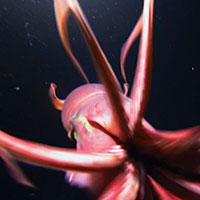 ORCA founder films giant squid in scientific first
ORCA founder films giant squid in scientific first
STORY
Ocean Research and Conservation Association founder Dr. Edie Widder pulled off a spectacular scientific first when she filmed a giant squid last summer 2,300 feet down in the cold waters of the Pacific off the coast of Japan.
The footage, which has been kept under wraps until now, will air Jan. 27 as part of the Discovery Channel documentary, “Monster Squid: The Giant is Real.”
“This massive predator has always been shrouded in secrecy, and every attempt to capture a live giant squid on camera in its natural habitat, considered by many to be the Holy Grail of natural history filmmaking, has failed – until now,” according to Discovery.
Richard Ellis is the author of “The Search for the Giant Squid: The Biology and Mythology of the World’s Most Elusive Sea Creature.”
“People have been searching for them for hundreds of years, literally,” Ellis told CNN when word of the video leaked and went viral on the Internet last week.
Widder, who spends most of her days at ORCA’s headquarters in the old Coast Guard station on the Fort Pierce Inlet, solved the scientific mystery in dramatic fashion, capturing giant squid on video five times in nine attempts, demonstrating an ability to film the legendary 60-foot-long animals more or less at will.
She traveled to Japan last summer as part of a multi-million-dollar expedition, one of many that have been mounted to try and film Architeuthis, the Latin name for the genus several giant squid species belong to. The expedition was funded by the Japanese public television network NHK and Discovery Channel.
“There were 41 people on board the research ship, including producers, cameramen, technicians, engineers and scientists,” Widder says. “The atmosphere was tense until we got the first footage. The NHK people had a lot riding on success of the expedition.”
Widder was one of three scientists chosen for the research mission. Each scientist used a different method to try and lure a giant squid within camera range.
“NHK had it set up as a kind of reality show competition to see who would find one first,” Widder says. “Steve O’Shea from New Zealand was using a chemical lure; Dr. Tsunemi Kobodera of the National Science Museum of Japan, who has devoted much of his career to searching for giant squid, used bait; and I used the Medusa. Kobodera said at the start we had about a one percent chance of success.”
Medusa is an ingenious device invented by Widder and refined by her and Justin Marshall, a collaborator at the University of Queensland in Australia.
It uses a special red light invisible to sea creatures to illuminate the filmed area, a super-sensitive camera to record images and an optical lure that mimics a bioluminescent jellyfish to attract predators such as squid.
“The electronic lure imitates a jellyfish common in the deep ocean that lights up when it is attacked,” says Widder. “The light is a scream for help, a bioluminescent burglar alarm meant to be seen from a long way off to bring in large predators to attack whatever is attacking the jelly and afford it an opportunity to escape.”
Predators like squid have been programmed by evolution to recognize the jellyfish’s pinwheel of blue light as a dinner bell, and Widder has hilarious footage of one giant squid encompassing the Medusa with its razor toothed suckers and then doing a double take, squinting its dinner-plate-sized eye and blinking, trying to see where its meal went.
Widder got invited on the expedition by demonstrating her past success luring rare undersea creatures with the Medusa at a “squid conference” hosted by the NHK in the summer of 2010.
“The expedition was supposed to take place in 2011, but it was delayed by the tsunami,” Widder says.
She ended up joining the expedition near the Ogasawara islands 500 south of Tokyo in late June 2012. She and her two fellow scientists took turns cruising as deep as 3,000 feet in a Triton mini-sub made in Vero Beach equipped with lights, cameras and their lure of choice.
Widder also deployed a Medusa on its own, dangling it in mid-water at the end of a 700-meter line.
It was that quiet camera and optical lure combination that repeatedly filmed giant squid swooping in from the primordial darkness in search of prey.
“We filmed the first squid on July 1 during the Medusa’s second deployment,” Widder says. “I said ‘Oh, God’ about seven times!”
All five squid filmed by Widder were caught in the camera’s covert light around 5 a.m. when they were migrating vertically from closer to the surface where they hunt at night back down into the deeper darkness where they are believed to hide during daylight hours.
Kobodera also had success after years of trying, luring one squid with bait and filming it from the submarine.
“We’re finally going to learn how this thing moves,” Ellis told CNN last week. “How it swims and what it does with its arms when it swims.”
Widder’s success may convince other scientists there are better ways of exploring the deep seas.
Most explorers have relied on bright lights and noisy machines to probe the dark ocean depths, scaring away the shy underwater creatures they are looking for.
“We have only explored five percent of the ocean and we have been doing it badly,” Widder says. “We knew about the existence of the giant squid only because they happen to float when they die. What about all the stuff that doesn’t float?”
Widder says the thought of all the amazing things still to be discovered in the deep ocean evokes “glorious scientific curiosity.”
“Monster Squid: The Giant is Real” will be the season finale of the Curiosity series on Discovery Channel. It will premiere Jan. 27 at 8 p.m.








